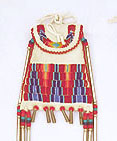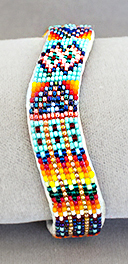
![]() Back to Native American Crafts Information Menu
Back to Native American Crafts Information Menu
Origins
Before contact with European civilization, Native Americans on both continents were making beautiful objects decorated with natural materials obtained from their own area or through trade. Trade routes crossed the Americas and extended to the Caribbean Islands, giving access to a variety of material: shell, metals, semi-precious stones, bone, ivory and, feathers, to name some of the most common trade items. (Lois Sherr Dubin, North American Indian Jewelry and Adornment) Beads, painstakingly made from bone and shell, had many uses, including breastplates and wampum.
The arrival of explorers and traders from Europe changed the materials Native Americans used, as well as influencing traditional patterns. The Spanish, English, Dutch and French offered glass beads as presents as well as inducements to religious conversion. Native Americans quickly adopted the new material, incorporating glass beads into traditional patterns. Although the first traders offered the finest beads they could get, including amber, millifiori and faceted chevron beads, soon the Native Americans were asking for beads in specific materials, colors and shapes. (North American Indian Jewelry and Adornment)
Most of these early beads came from the glass factories of Murano, Venice; a few came from France and the Netherlands. According to Georg Barth (Native American Beadwork), Venetian beads had softer colors; glass beads made in Bohemia (Czech Republic) and introduced in the 19th Century were brighter and had a bluish cast. Both the new colors and the more uniform size of the Czech beads appealed to Native American beaders. This resulted in a decline in the use of Venetian beads.
Because the dominant culture and religion discouraged traditional practices and beliefs, Native Americans began to incorporate traditional concepts into their beadwork. For example, Arctic tribes transformed tattoo patterns into elaborately beaded parkas; further south, certain colors and patterns came to have special meanings in Native American beadwork. (North American Indian Jewelry and Adornment)
As glass beads spread across North America, each tribe used them to express their own patterns and traditions. Today, bead artists borrow beading techniques and patterns from each other. Many create new beadwork patterns based on tribal culture and traditions.
Native American Beadwork Styles (from Native American Beadwork by Georg Barth)
Lane Stitch. Sometimes called Lazy Stitch, this method of beadwork uses "lanes" of beads to cover large areas with regular rows of beads. It may also be used to outline work done in Overlay Stitch. Lane Stitch was used by Northern Plains and Plateau tribes to decorate items such as clothing, pouches, and tepees.
 Example of Native American Lane Stitch
Example of Native American Lane Stitch
Overlay Stitch. A style of beading used for covering a large area with beads common throughout North America. Traditionally, it was done with two threaded needles, not one. Most Subarctic and Woodland floral beadwork was done in the Overlay Stitch.
 Example of Native American Overlay stitched beadwork
Example of Native American Overlay stitched beadwork
Transmontane or Crow Stitch. A style of Lane Stitch where different elements of the pattern are beaded as separate units. Where the various units meet, there is usually an outline composed of a single row of beads. This stitch was very often combined with Overlay and Lane stitching.
Woven or Loom Work. Beadwork is woven on different kinds of handlooms. Various weaving styles may be used. Traditionally, Indians of the Northern Woodlands area used this stitch for bandolier bags, sashes and hair ties. Bead weaving is now done by Native Americans throughout North American. Most hat bands, belts and many cuff bracelets are loomed.
 Example of Native American Loomed Beadwork
Example of Native American Loomed Beadwork
Peyote or Gourd Stitch. A special type of net beading used to cover the handles of religious objects used in Native American Church ceremonies. This stitch allows the beader to create a pattern by beading around a circular object. Smaller sized cut beads are commonly used, as well as seed beads. Peyote stitch is now used to decorate stemmed glasses, salt and pepper shakers and key holders.
 Example of Native American Peyote Stitch
Example of Native American Peyote Stitch
Brick Stitch. A different style of Gourd Stitch in which the number of beads needed to go around the circumference of the item to be beaded must be divisible by two instead of by three. Brick stitch beaded items have the appearance of alternating rows of brickwork, which is where name came from.
What to Look for in Native American Beadwork
Beads. Modern, factory produced beads such as Delica or Czech cut beads are more uniform in size than vintage or antique beads. Even so, you may notice that beads of one color are narrower than those of other colors. This is particularly true of vintage and antique beads. (Native American Beadwork)
In general, the smaller the size of bead used, the more beads and time needed to complete the beadwork. Since good quality seed beads are no longer cheap, and vintage and antique beads are very expensive, a significant part of the price of a beaded item may be the cost of the beads. As with other jewelry, object size is not always a measure of value.
Bead Size. Bead size is defined as the number of rows of a given size bead that will cover one square inch. The larger the number, the smaller the bead: 14º beads require 14 rows of beads per inch. 10º beads only need 10 rows. Sizes between 10 and 20 describe seed or cut beads; numbers between 6 and 9, pony beads.
Bead Colors. Today good quality seed beads come from Japan as well as the Czech Republic. However, each year only a limited number of colors are made and sold. Therefore, a color that was available last year may not be available this year. Many bead artists collect beads for years so that they will have just the colors they want to complete a piece of work.
Thread. Traditional beading was done using sinew. Many beaders today use polyester thread, available in various kinds and qualities. Georg Barth, however, advocates using mercerized cotton thread waxed with bee's wax. (Native American Beadwork) You can tell which kind of thread was used in a piece of beadwork by looking at it. Cotton, of course, is opaque, whereas polyester thread is translucent, either clear or a yellowish color.
Craftsmanship. Good quality beadwork will lay flat without loose beads or irregular stitches. The beads are evenly spaced and the thread tight. Unless different sizes of beads were intentionally used, the beads should be fairly uniform in size.
Loom work should lay straight and flat, and should be the same width throughout. Knots where a new thread was added should not be visible.
Signature. Many bead artists don't sign their work. Some consider their original patterns to be their signature. Some artists use a particular kind of knot as a signature.
![]() Shop for Native American Beadwork Hair
Accessories
Shop for Native American Beadwork Hair
Accessories
![]() Shop for Native American Beadwork Bracelets
Shop for Native American Beadwork Bracelets
![]() Shop for Native American Beadwork Earrings
Shop for Native American Beadwork Earrings
![]() Shop for Native American Beadwork Hat Bands
Shop for Native American Beadwork Hat Bands
![]() Shop for Native American Beadwork Necklaces
Shop for Native American Beadwork Necklaces
![]() Shop for Native American Beadwork Key Holders
Shop for Native American Beadwork Key Holders
![]() Shop for Native American Beadwork
Pouches and Purses
Shop for Native American Beadwork
Pouches and Purses
![]() Shop for Native American Beadwork Belts
Shop for Native American Beadwork Belts
This information is provided to help you in selecting and evaluating Native American jewelry and crafts.
We are happy to answer questions by email.
Please note that Coyote's Game does not buy or sell used or vintage beadwork, nor do we appraise Native American beadwork.
Email us at
© 1999-2025 Coyote's Game. Reproduction without permission is prohibited.
